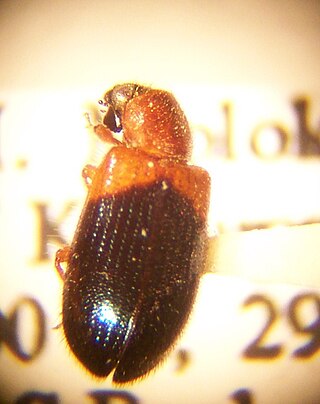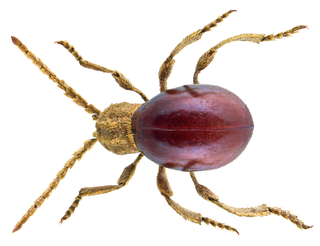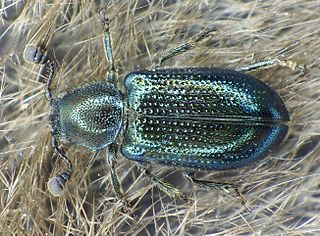
The Asian long-horned beetle, also known as the starry sky, sky beetle, or ALB, is native to the Korean Peninsula, northern and southern China, and disputably in northern Japan. This species has now been accidentally introduced into the eastern United States, where it was first discovered in 1996, as well as Canada, and several countries in Europe, including Austria, France, Germany, Italy and UK.

Dermestidae are a family of Coleoptera that are commonly referred to as skin beetles. Other common names include larder beetle, hide or leather beetles, carpet beetles, and khapra beetles. There are over 1,800 species described.

A bark beetle is the common name for the subfamily of beetles Scolytinae. Previously, this was considered a distinct family (Scolytidae), but is now understood to be a specialized clade of the "true weevil" family (Curculionidae). Although the term "bark beetle" refers to the fact that many species feed in the inner bark (phloem) layer of trees, the subfamily also has many species with other lifestyles, including some that bore into wood, feed in fruit and seeds, or tunnel into herbaceous plants. Well-known species are members of the type genus Scolytus, namely the European elm bark beetle S. multistriatus and the large elm bark beetle S. scolytus, which like the American elm bark beetle Hylurgopinus rufipes, transmit Dutch elm disease fungi (Ophiostoma). The mountain pine beetle Dendroctonus ponderosae, southern pine beetle Dendroctonus frontalis, and their near relatives are major pests of conifer forests in North America. A similarly aggressive species in Europe is the spruce ips Ips typographus. A tiny bark beetle, the coffee berry borer, Hypothenemus hampei is a major pest on coffee plantations around the world.

The forest bug or red-legged shieldbug is a species of shield bug in the family Pentatomidae, commonly found in most of Europe. It inhabits forests, woodlands, orchards, and gardens.

Hylotrupes is a monotypic genus of woodboring beetles in the family Cerambycidae, the longhorn beetles. The sole species, Hylotrupes bajulus, is known by several common names, including house longhorn beetle, old house borer, and European house borer. In South Africa it also is known as the Italian beetle because of infested packing cases that had come from Italy. Hylotrupes is the only genus in the tribe Hylotrupini.

Cleridae are a family of beetles of the superfamily Cleroidea. They are commonly known as checkered beetles. The family Cleridae has a worldwide distribution, and a variety of habitats and feeding preferences.

Lasioderma serricorne, more commonly referred to as the cigarette beetle, cigar beetle, or tobacco beetle, is a small beetle that shares a remarkable resemblance with the drugstore beetle and the common furniture beetle. The cigarette beetle, along with the drugstore and furniture beetles, all belong to the Ptinidae beetle family. The cigarette beetle can be distinguished from A. punctatum by its flatter thorax, whereas the A. punctatum boasts a humped thorax. The cigarette beetle can be further differentiated from S. paniceum with its uniformly serrated antennae composed of 11 segments, unlike the three-segmented antennae of S. paniceum. Additionally, L. serricorne has more shallow grooves in its elytra, or hardened wing covers, compared to the A. punctatum and S. paniceum’s deep grooving.

Dermestes maculatus is a species of beetle with a worldwide distribution, being present on all continents except Antarctica. In Europe, it is present in all countries.
Home-stored product entomology is the study of insects that infest foodstuffs stored in the home. It deals with the prevention, detection and eradication of pests.

The minute tree-fungus beetles, family Ciidae, are a sizeable group of beetles which inhabit Polyporales bracket fungi or coarse woody debris. Most numerous in warmer regions, they are nonetheless widespread and a considerable number of species occur as far polewards as Scandinavia for example.

Necrobia ruficollis, the ham beetle, red-shouldered ham beetle, or red-necked bacon beetle, is a mostly carnivorous beetle in the family Cleridae with a cosmopolitan distribution.

Korynetes caeruleus, also known as the steely blue beetle, is a predatory beetle in the family Cleridae. The species name is occasionally misspelled as "coeruleus" (e.g.,), but the spelling caeruleus is preserved by Opinion 604 of the ICZN, issued in 1961.
Lardoglyphus zacheri is a species of mite first discovered by Friedrich Zacher in a dermestid beetle culture. The genus Lardoglyphus was erected by Anthonie Cornelis Oudemans in 1927. The species is known to be a pest to institutional and private dermestid beetle colonies.

Mezium affine is a species of beetle in the family Ptinidae. Its common names include shiny spider beetle, northern spider beetle, and hood spider beetle. It occurs throughout the Northern Hemisphere, and it is an introduced species in Australia.

Agriotes sputator is a species of click beetle, commonly known as the common click beetle. The adult beetle is brown and inconspicuous, and the larvae live in the soil and are known as wireworms. They are agricultural pests that devour the roots and underground parts of many crops and other plants.

The cheese fly, cheese skipper, or ham skipper is a species of fly from the family Piophilidae whose larvae are known to infest cured meats, smoked or salted fish, cheeses and carrion. On the Mediterranean island of Sardinia, the larvae are intentionally introduced into pecorino cheese to produce the characteristic casu martzu. If consumed by humans, the larvae have a chance to survive in the intestine, causing enteric myiasis, though no such cases have been linked to casu martzu dishes.

Dermestes ater is a species of beetle in the family Dermestidae, the skin beetles. It is known commonly as the black larder beetle or incinerator beetle. It is native to North America, but today it is found nearly worldwide. Like several other dermestid beetles, this species is a common pest of stored products.

Carpophilus is a genus of sap beetles. Several species are agricultural pests, typically causing feeding damage to a variety of fruits, grains and other food products worldwide. The genus contains a great number of species.

Necrobia violacea is a species of beetle in family Cleridae. Cleridae beetles are a predaceous beetle found within forest and woodland environments, and can be associated with stored food products as both pests and predators of other insects.
Cymatodera wolcotti, also known as Wolcott's blister beetle, is a species of checkered beetle in the family Cleridae. It is commonly found in North America. It is named after Albert Burke Wolcott (1869-1950).

















